Aramids

Aramids are a family of nylons, including Nomex® and Kevlar ®. Kevlar ® is used to make things like bullet proof vests and puncture resistant bicycle tires. I suppose one could even make bullet proof bicycle tires from Kevlar ® if one felt the need.
Blends of Nomex and Kevlar ® are used to make fireproof clothing. Nomex ®is what keeps the monster truck and tractor drivers from burning to death should their fire-breathing rigs breathe a little too much fire. Thanks to Nomex ®, an important part of American culture can be practiced safely. (Polymers play another part in the monster truck show in the form of elastomers from which those giant tires are made.) Nomex ®-Kevlar ® blends also protect fire fighters.
Kevlar ® is a polyamide, in which all the amide groups are separated by para-phenylene groups, that is, the amide groups attach to the phenyl rings opposite to each other, at carbons 1 and 4. Kevlar ® is shown in the big picture at the top of the page.
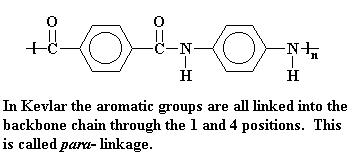
Nomex ®, on the other hand, has meta-phenylene groups, that is, the amide groups are attached to the phenyl ring at the 1 an 3 positions.
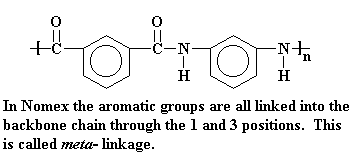
Kevlar ® is a very crystalline polymer. It took a long time to figure out how to make anything useful out of Kevlar ® because it wouldn't dissolve in anything. So processing it as a solution was out. It wouldn't melt below a right toasty 500 oC, so melting it down was out, too. Then a scientist named Stephanie Kwolek came up with a brilliant plan.
Aramids are used in the form of fibers. They form into even better fibers than non-aromatic polyamides, like nylon 6,6.
Why? Why?
Ok, since it seems everyone just has to know, I'll tell you. It has to do with a little quirky thing that amides do. They have the ability to adopt two different shapes, or conformations. You can see this in the picture of a low molecular weight amide. The two pictures are the same compound, in two different conformations. The one on the left is called the trans conformation, and the one on the right is the cis- conformation.

In Latin, trans means "on the other side". So when the hydrocarbon groups of the amide are on opposite sides of the peptide bond, the bond between the carbonyl oxygen and the amide nitrogen, its called a trans- amide. Likewise, cis in Latin means "on the same side", and when both hydrocarbon groups are on the same side of the peptide bond, we call it a cis- amide.
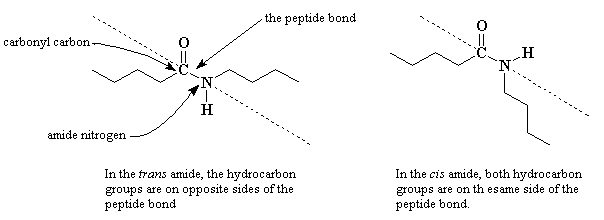
The same amide molecule can twist back and forth between the cis- and trans- conformations, given a little bit of energy.
The same cis- and trans- conformations exist in polyamides, too. When all the amide groups in a polyamide, like nylon 6,6 for example, the polymer is fully stretched out in a straight line. this is exactly what we want for fibers, because long straight, fully extended chains pack more perfectly into the crystalline form that makes up the fiber. But sadly, there's always at least some amide linkages in the cis- conformation. So nylon 6,6 chains never become fully extended.
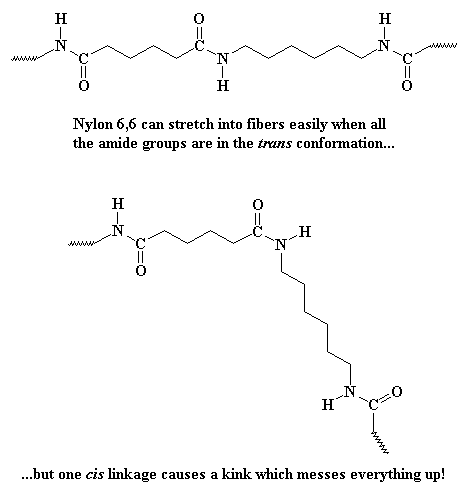
But Kevlar ® is different. When it tries to twist into the cis- conformation, the hydrogens on the big aromatic groups get in the way! The cis conformation puts the hydrogens just a little closer to each other than they want to be. So Kevlar ® stays nearly fully in the trans- conformation. So Kevlar can fully extend to form beautiful fibers.
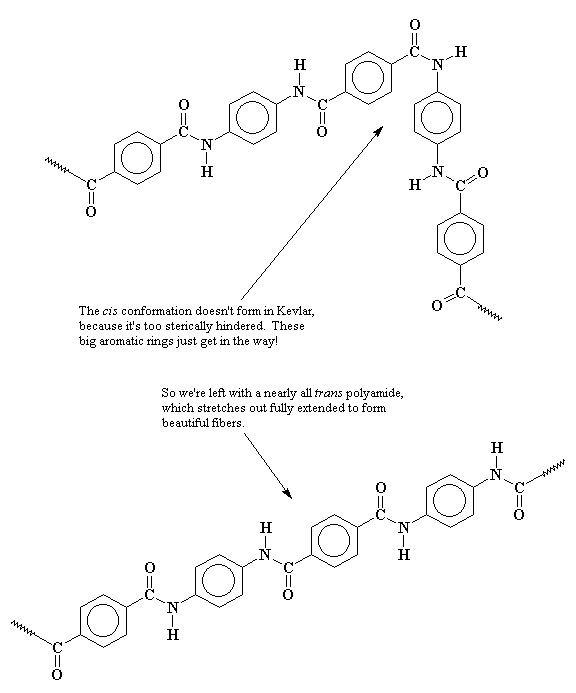
Now it may help to look at a close-up picture of this. Look at the picture below and you can see that when Kevlar ® tries to form the cis- conformation, there's not enough room for the phenyl hydrogens. So only the trans- conformation is usually found.
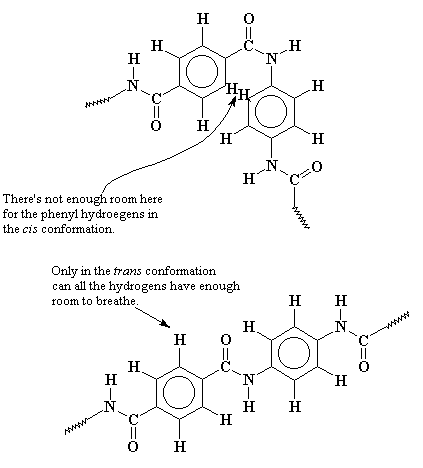
But there's another polymer that stretches out even better called ultra-high molecular weight polyethylene. It even replaced Kevlar ® for making bullet-proof vests!
But back to Kevlar ® ...
Also the phenyl rings of adjacent chains stack on top of each other very
easily and neatly, which makes the polymer even more crystalline, and
the fibers even stronger.

|

|
|
|
Back to Main Page |
Back to NOMEX Web Page |
 at market@pleo.com
at market@pleo.com
 ® is P. Leo & Co., Ltd. trade mark.
® is P. Leo & Co., Ltd. trade mark.